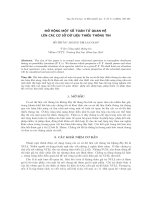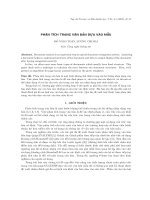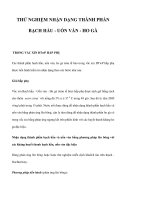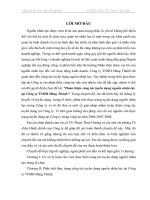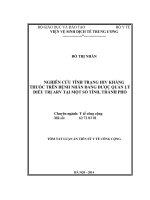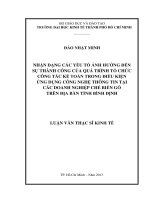Nhận dạng thanh mềm công xôn
Bạn đang xem bản rút gọn của tài liệu. Xem và tải ngay bản đầy đủ của tài liệu tại đây (4.38 MB, 66 trang )
ĐẠI HỌC QUỐC GIA TP. HCM
TRƯỜNG ĐẠI HỌC BÁCH KHOA
--------------------
NGUYỄN VĂN THUẬT
NHẬN DẠNG THANH MỀM CÔNG XÔN
IDENTIFICATION OF A FLEXIBLE CANTILEVER BEAM
Chuyên ngành: Kỹ thuật cơ điện tử
Mã số: 8.52.01.14
LUẬN VĂN THẠC SĨ
TP. HỒ CHÍ MINH, tháng 9 năm 2020
CƠNG TRÌNH ĐƯỢC HỒN THÀNH TẠI
TRƯỜNG ĐẠI HỌC BÁCH KHOA - ĐHQG - HCM
Cán bộ hướng dẫn khoa học: PGS.TS. Nguyễn Quốc Chí
Cán bộ chấm nhận xét 1: PDG.TS. Nguyễn Thanh Phương
Cán bộ chấm nhận xét 2: TS. Lê Ngọc Bích
Luận văn thạc sĩ được bảo vệ tại Trường Đại học Bách Khoa, ĐHQG Tp. HCM
ngày 03 tháng 09 năm 2020
Thành phần Hội đồng đánh giá luận văn thạc sĩ gồm:
(Ghi rõ họ, tên, học hàm, học vị của Hội đồng chấm bảo vệ luận văn thạc sĩ)
1. Chủ tịch: PGS.TS. Nguyễn Tấn Tiến
2. Thư ký: TS. Trần Việt Hồng
3. Phản biện 1: PGS.TS Nguyễn Thanh Phương
4. Phản biền 2: TS. Lê Ngọc Bích
5. Ủy viên: TS. Ngơ Hà Quang Thịnh
Xác nhận của Chủ tịch Hội đồng đánh giá LV và Trưởng Khoa quản lý chuyên
ngành sau khi luận văn đã được sửa chữa (nếu có).
CHỦ TỊCH HỘI ĐỒNG
TRƯỞNG KHOA
ĐẠI HỌC QUỐC GIA TP.HCM
TRƯỜNG ĐẠI HỌC BÁCH KHOA
CỘNG HÒA XÃ HỘI CHỦ NGHĨA VIỆT
NAM Độc lập - Tự do - Hạnh phúc
NHIỆM VỤ LUẬN VĂN THẠC SĨ
Họ tên học viên: NGUYỄN VĂN THUẬT
MSHV: 1870071
Ngày, tháng, năm sinh: 05/02/1995
Nơi sinh: Lâm Đồng
Chuyên ngành: Kỹ thuật Cơ Điện Tử
Mã số : 1870071
I. TÊN ĐỀ TÀI :
NHẬN DẠNG THANH MỀM CÔNG XÔN
IDENTIFICATION OF A FLEXIBLE CANTILEVER BEAM
II. NHIỆM VỤ VÀ NỘI DUNG :
- Xây dựng mơ hình động lực học sử dụng phương pháp Galerkin cho hệ thống
dầm cơng xơn có bệ gá đặt chuyển động theo phương ngang.
- Xây dựng phương pháp nhận dạng hệ thống dầm công xôn.
- Thực hiện phỏng trên mơ hình số và thực nghiệm tìm các thơng số của hệ
thống dầm cơng xơn trên mơ hình thí nghiệm.
III. NGÀY GIAO NHIỆM VỤ : 19/08/2019
IV. NGÀY HỒN THÀNH NHIỆM VỤ : 07/06/2020
V. CÁN BỘ HƯỚNG DẪN : PGS. TS. NGUYỄN QUỐC CHÍ
Tp. HCM, ngày 20 tháng 08 năm 2019
CÁN BỘ HƯỚNG DẪN
(Họ tên và chữ ký)
CHỦ NHIỆM BỘ MÔN ĐÀO TẠO
(Họ tên và chữ ký)
TRƯỞNG KHOA
(Họ tên và chữ ký)
ACKNOWLEDGMENT
I would like to sincerely and wholeheartedly thank Assoc. Prof. Nguyen Quoc Chi for
his guidance and kindness throughout this work. His patience as an advisor, boundless
energy while teaching, and giving passion for research are to be commended and worth
emulating. I am indebted to him for cajoling me into doing experiments and thus opening
a whole new exciting world for me. His inspiration gives me the ability, mindset, and
perseverance to be where I am now.
I thank Thinkalpha Co., Ltd members for making time in their busy schedules to
comments at various stages of my Master's program and help me out on setting up the
experimental system.
A special thanks to Siqi Pan and Assoc. Prof. James S. Welsh at the University of
Newcastle - Australia for their valuable suggestions and help with experiments. Their
cooperation has sprung a great impact on our research work.
Most importantly, I would like to thank my parents for their unconditional support, love,
and affection. Their encouragement and neverending kindness made everything easier
to achieve.
ABSTRACT
The theoretical and experimental solutions for vibrations of a flexible cantilever beam
are studied, which could be found widely in mechanical structures. This thesis
considers the modeling, simulation, and experiment to identify the parameters of a
flexible cantilever beam subjected to a moving hub. First, we investigate in modeling
a flexible cantilever beam that can be used to obtain its behaviors through numerical
simulation. The second objective is to develop a method to identify the parameter of
the system. To this end, we construct an experimental system. Experimental
techniques, such as forced vibration and pulse propagation, have been used to measure
the behaviors and damping of materials. Through simple experiments at various
frequencies, the response of a cantilever beam subjected to a moving hub. This
response was successfully modeled with a theoretical solution that includes the
presence of damping.
TÓM TẮT LUẬN VĂN
Các phương pháp lý thuyết và thực nghiệm cho dao động của dầm công xôn mềm
được nghiên cứu, loại dầm có thể được tìm thấy rộng rãi trong các kết cấu cơ khí.
Luận văn này xây dựng mơ hình hóa, mô phỏng và thực nghiệm để xác định các thông
số của dầm công xôn mềm gắn trên một bệ chuyển động. Đầu tiên, chúng tơi nghiên
cứu mơ hình hóa một dầm công xôn mềm để thu được các đáp ứng của dầm thông qua
mô phỏng số. Mục tiêu thứ hai là phát triển một phương pháp xác định các tham số
của hệ thống. Để đạt được mục tiêu này, chúng tôi xây dựng một hệ thống thử nghiệm.
Các kỹ thuật thực nghiệm, chẳng hạn như rung cưỡng bức và lan truyền xung, đã được
sử dụng để đo đáp ứng và giảm chấn của dầm. Thơng qua các thí nghiệm đơn giản ở
các tần số khác nhau, đáp ứng của dầm công xôn chịu tác động của một bệ chuyển
động. Đáp ứng này đã được mơ hình hóa thành cơng với giải pháp từ lý thuyết bao
gồm sự hiện diện của giảm chấn.
LỜI CAM ĐOAN
Tôi xin cam kết tất cả nội dung của luận văn này không hề sao chép các công trình
nghiên cứu của các cá nhân hay các tổ chức.
Tơi xin thực hiện nghiêm túc việc trích dẫn các cơng trình bài báo, tham luận đã
cơng bố được sử dụng trong luận văn.
HỌC VIÊN
NGUYỄN VĂN THUẬT
TABLE OF CONTENTS
CHAPTER 1: INTRODUCTION ................................................................................. 1
1.1
Motivation .......................................................................................................... 1
1.2
Objectives and Scope of The Dissertation.......................................................... 4
CHAPTER 2: FLEXIBLE BEAM MODELING ........................................................ 6
2.1
Equations of Motion of The Moving Cantilever Beam ...................................... 6
2.2
Derivation of Equation of Motion ...................................................................... 7
2.2.1
The variation with respect to variable ...................................................... 7
2.2.2
The variation with respect to variable 𝑤 ..................................................... 9
2.3
The Galerkin Decomposition ........................................................................... 10
2.3.1
Modal shape function................................................................................. 10
2.3.2
Ordinary differential equations .................................................................. 13
CHAPTER 3: IDENTIFICATION METHOD ......................................................... 17
3.1
Introduction to Experimental Modal Analysis. ................................................ 17
3.2
Estimation of Frequency-Response Functions ................................................. 19
3.3
Modal Parameter Estimation ............................................................................ 24
3.4
Measurement Techniques ................................................................................. 26
3.4.1
Basic Measurement System. ...................................................................... 26
3.4.2
Excitation Methods And Measurement ..................................................... 28
3.4.3
Single-Frequency Excitation ..................................................................... 28
3.4.4
Broadband Excitation ................................................................................ 29
3.4.5
Calibration ................................................................................................. 30
CHAPTER 4: NUMERICAL SIMULATION AND EXPERIMENTAL RESULTS
........................................................................................................................................ 32
4.1
Numerical Simulation Result ........................................................................... 32
4.2
Experimental Results ........................................................................................ 34
CHAPTER 5: CONCLUSIONS ................................................................................. 51
REFERRENCE ............................................................................................................ 52
APPENDIX: The CONTSID Toolbox: A Software Support for Data-based
Continuous-time Modelling ......................................................................................... 54
LIST OF FIGURES
Figure 1.1 Cantilever beam structures. ............................................................................ 1
Figure 2.1 Configuration of vibration cantilever beam.................................................... 6
Figure 3.1 Interrelation among dynamic models. .......................................................... 19
Figure 3.2 Measurement system with noise sources. ..................................................... 21
Figure 4.1 Time response of the chirp excitation and output signal. ............................. 33
Figure 4.2 Simulation frequencies response of the system. ........................................... 33
Figure 4.3 Comparison of the response obtained by the experiment and the numerical
simulation ....................................................................................................................... 34
Figure 4.4 Schematic diagram of the experimental set-up............................................. 35
Figure 4.5 The studied beam with a dark background. .................................................. 36
Figure 4.6 Measured points in the beam. ....................................................................... 37
Figure 4.7 Calibration procedure set-up ........................................................................ 38
Figure 4.8 Curve fitting line converting the pixels value (from camera) to mm value
(from laser sensor). ......................................................................................................... 38
Figure 4.9 Measured chirp input and output signal in time domain. ............................. 42
Figure 4.10 The two resonance frequencies with the chirp input signal. ...................... 43
Figure 4.11 Experimental measured input and output signals. ...................................... 46
Figure 4.12 Signal spectrum analyzing. ......................................................................... 46
Figure 4.13 Bode diagram of estimated model at 10mm. .............................................. 47
Figure 4.14 Bode diagram of estimated model at 225mm. ............................................ 47
Figure 4.15 Model predicted output y10 using dataset E1 vs. validation output V2 ..... 49
Figure 4.16 Model predicted output y225 using dataset E1 vs. validation output V2 ... 49
Figure 4.17 Comparison of estimated models’ responses vs. the validation step signal.
........................................................................................................................................ 50
LIST OF TABLES
Table 4.1 System Parameters. ........................................................................................ 32
Table 4.2 Model order selection results using dataset E2 for output at 10mm. ............. 41
Table 4.3 Model order selection results using dataset E2 for output at 225mm. ........... 42
Table 4.4 Excitation signal and its function. .................................................................. 43
Table 4.5 Estimated model parameters and validation results at 10mm. ....................... 44
Table 4.6 Estimated model parameters and validation results at 225mm. ..................... 45
Table 4.7 Modal parameters for the identified models. ................................................. 48
Table 4.8 The fitness percentage (FP) of identified models with step signal. ............... 50
CHAPTER 1: INTRODUCTION
1.1 Motivation
Cantilever beams can represent many structures in mechanical, civil, and electronics
engineering (for example, MEMS structure). For details, the cantilever beams also can
be found in high-speed applications such as fast manipulators, micro CNC milling
machines, coordinate measuring machines (CMM), atomic force microscopies (AFM).
It is shown that the cantilever beam structures yield is a viable solution for the case of
lightweight and compact size. However, it is well known that the lightweight structures
may result in vibrations when the cantilever beam moves, especially in the case of highspeed motion. Therefore, the vibrations of the cantilever beam need to be analyzed
during motions of the cantilever beam. In this case, the beam is considered flexible.
(a) Atomic Force Microscope
(b) Coordinate-measuring machine
(d) Gantry system
(c) Micro CNC milling machines
Figure 1.1 Cantilever beam structures.
1
In the development of dynamic models of the flexible cantilever beam, Timoshenko
beam theory [1] and Euler Bernoulli beam theory [2] have been employed. The dynamic
models based on Timoshenko beam theory are complex due to the assumption of the
existence of the shear deformation, which results in the non-orthogonality of the neutral
axis and cross-sectional area of the beam. In contrast, in the case of Euler-Bernoulli beam
theory used, the dynamic models of the cantilever beam system are developed by using
the extended Hamilton’s principle [3], and the partial differential equations (PDE)
governing the vibrations of the beam are derived by the Hamiltonian differential
equation. In the case of the flexible cantilever beam fixed on the moving hub, the PDEs
describing the vibrations of the beam are nonlinear [4] because of the effects of the
motions of the hub. The nonlinearity of the PDEs may yield complexity for dynamic
analysis of the flexible beam. To overcome this problem, approximation methods such
as the Galerkin decomposition [5] and the finite element method [6] are used. These
methods convert the PDEs with infinite order into a set of ordinary differential equations
(ODEs) with finite order. The accuracy of models using the ODEs depends on the order
of ODEs.
Vibration control methods to reduce oscillations of the cantilever beam systems with the
moving hubs have been developed based on PDE models [7] and ODE models. In terms
of the PDE based control methods, in the work [8], a boundary control scheme is
proposed for a flexible articulated wing on a robotics aircraft, where the control design
is performed by the backstepping technique. Dadfarnia et al. [7] developed a control
method for a translational Euler-Bernoulli beam, in which the control algorithm is
designed to drive the moving hub and to suppress the vibration of the flexible beam. The
advantage of the ODE models is to facilitate the applications of the control theories for
ODE systems, which are well established. In the research [9], an ODE model developed
by the Galerkin method was used to design nonlinear control laws for a two-link flexible
manipulator.
2
Experimental techniques, such as free-vibration decay, forced vibration, rotating-beam
deflection, and pulse propagation, have been widely used to measure the dynamic elastic
modulus and damping of materials. These methods are now accompanied by numerical
simulations, which play an important role in modern vibration analysis. These solutions
give reliable answers if the experiments have practical problems, are too expensive or it
is impossible to analyze the problem with analytical methods [10].
In particular, models based on beam-like elements, with different boundary conditions,
can be used to simulate the response of structures in engineering applications. For
example, we can model the vibrational response of spacecraft antennae, robot arms,
building components, bridge structures, and parts of musical instruments.
Experimental testing and system identification play a key role because they help the
structural
dynamicist
to
reconcile
numerical
predictions
with
experimental
investigations. The term ‘system identification’ is sometimes used in a broader context
in the technical literature and may also refer to the extraction of information about the
structural behavior directly from experimental data, i.e., without necessarily requesting
a model (e.g., identification of the number of active modes or the presence of natural
frequencies within a certain frequency range). In the scope of the dissertation, system
identification refers to the development (or the improvement) of structural models from
input and output measurements performed on the real structure using vibration sensing
devices.
Linear system identification is a discipline that has evolved considerably during the last
30 years [11]. Modal parameter estimation termed modal analysis is indubitably the most
popular approach to performing linear system identification in structural dynamics. The
model of the system is known to be in the form of modal parameters, namely the natural
frequencies, mode shapes, and damping ratios. The popularity of modal analysis stems
3
from its great generality; modal parameters can describe the behavior of a system for any
input type and any range of the input.
The fact that the structure under different conditions could display nonlinear distortions
phenomena. In structural dynamics, typical sources of nonlinearities are [11]:
Geometric nonlinearity results when a structure undergoes large displacements
and arises from the potential energy.
Inertia nonlinearity derives from nonlinear terms containing velocities and/or
accelerations in the equations of motion, and takes its source in the kinetic energy
of the system (e.g., convective acceleration terms in a continuum and Coriolis
accelerations in motions of bodies moving relative to rotating frames).
A nonlinear material behavior may be observed when the constitutive law relating
stresses and strains is nonlinear.
Damping dissipation is essentially a nonlinear and still not fully modeled and
understood phenomenon. The modal damping assumption is not necessarily the
most appropriate representation of the physical reality, and its widespread use is
to be attributed to its mathematical convenience.
Nonlinearity may also result due to boundary conditions (for example, free
surfaces in fluids, vibro-impacts due to loose joints or contacts with rigid
constraints, clearances, imperfectly bonded elastic bodies), or certain external
nonlinear body forces (e.g., magnetoelastic, electrodynamic, or hydrodynamic
forces).
1.2 Objectives and Scope of The Dissertation
The primary goal of the present dissertation is to improve the state of knowledge
regarding the structural dynamic response of flexible cantilever beams. In order to
achieve this goal experimental, numerical, and analytical methods are used to
characterize the time-dependent strain and displacement fields of flexible cantilever
beams.
4
The remainder of the dissertation is organized in the following manner. First, in Chapter
2 a comprehensive flexible cantilever beam modeling is provided. The details of the
model of structural dynamics of a cantilever beam attached to a moving base are
addressed thoroughly.
In Chapter 3, the overview of the identification method is explored. A brief description
of the continuous-time system identification (CONTSID) toolbox for MATLAB, which
supports continuous-time (CT) transfer function and state-space model identification
directly from regularly or irregularly time-domain sampled data, without requiring the
determination of a discrete-time (DT) model is provided.
In Chapter 4, a comprehensive description of the experimental setup is provided. The
details of the experimental procedure and numerical simulation are given, the associated
difficulties are addressed thoroughly. The numerical solution consists of Galerkin
method for spatial discretization and a high-order time-spectral method for temporal
discretization. The experimental setup consists of the cantilever beam attached to a
moving base and a vision camera system as well.
While numerical simulation can provide detail and fidelity, oftentimes analytical
solutions can provide insight into parameter dependence which is unattainable through
simulation. In addition, approximate analytical solutions can be used to improve
simulation efforts by uncovering possible scaling laws, thereby providing information to
reduce the number of simulations needed. Furthermore, analytical solutions can provide
guidance on how to improve numerical methods for solving the problem in question.
Finally, a summary of conclusions and suggestions for future works are given in Chapter
5. In particular, future work is given.
5
CHAPTER 2: FLEXIBLE BEAM MODELING
2.1 Equations of Motion of The Moving Cantilever Beam
Figure 1 shows a flexible cantilevered beam of constant length L. One end of the
beam is clamped into a translational hub with the mass m moved in the 1D plane by an
external force f(t). Moreover, shear deformation, rotary inertia, and the effect of axial
force are neglected.
Z
Z
w(z, t)
Z
w(z, t)
w(z, t)
u(z, t)
L
α(t)
O
O
X
O
X
X
f (t)
(a) 1st Mode
(c) Forced Vibration
(b) 2nd Mode
Figure 2.1 Configuration of vibration cantilever beam.
For a displacement of the hub α and an elastic deflection 𝑤, the total displacement
𝑢(𝑧, 𝑡) of a point along the beam at distance z from the hub can be described:
𝑢(𝑧, 𝑡) = 𝛼 (𝑡 ) + 𝑤(𝑧, 𝑡 )
(2.1)
The equations of motion for flexible Euler-Bernoulli beam will be derived using
Hamilton’s principle
𝑡𝑓
∫ (𝛿𝑇 + 𝛿𝑊 − 𝛿𝑃) 𝑑𝑡 = 0
𝑡0
6
(2.2)
where T, P, and W are the kinetic energy, potential energy, and work done by external
forces, respectively.
The total kinetic energy includes the kinetic energy of the hub, of the beam, and of
the tip load.
𝑇 = 𝑇ℎ + 𝑇𝑏
(2.3)
The kinetic energy of the hub
1
1
1
𝑚[𝑢̇ (0, 𝑡 )]2 = 𝑚[𝛼̇ (𝑡) + 𝑤̇(0, 𝑡 )]2 = 𝑚𝛼̇ 2 (𝑡)
2
2
2
The kinetic of the beam
𝑇ℎ =
1 𝐿
1 𝐿
2
𝑇𝑏 = ∫ 𝜌[𝑢̇ (𝑧, 𝑡 )] 𝑑𝑧 = ∫ 𝜌[𝛼̇ (𝑡) + 𝑤̇(𝑧, 𝑡 )]2 𝑑𝑧
2 0
2 0
(2.4)
(2.5)
In this case, the length of the beam is considered as a constant.
The total kinetic energy
𝐿
1
2
𝑇 = 𝑇ℎ + 𝑇𝑏 + 𝑇𝑡 = 𝑚𝛼̇ + ∫ 𝜌[𝛼̇ + 𝑤̇(𝑧, 𝑡 )]2 𝑑𝑧
2
0
(2.6)
Where 𝑚, 𝜌 are the mass of hub, the mass density per unit length.
The total potential energy (generate by bending moment of the beam) can be found as
𝐿
1
𝑃 = 𝐸𝐼 ∫ 𝑤 ″2 𝑑𝑥
2
0
(2.7)
Work Done by external forces to the beam is:
𝑊 = 𝑓(𝑡)𝛼(𝑡)
where the force f is applied to the hub to generate the motion (t).
2.2 Derivation of Equation of Motion
2.2.1 The variation with respect to variable
7
(2.8)
The variation of the kinetic energy with respect to variable 𝛼 can be written as:
1
1 𝐿
𝛿𝛼 𝑇 = 𝑚(2𝛼̇ 𝛿𝛼̇ ) + ∫ 𝜌[2𝛿𝛼̇ [𝛼̇ + 𝑤̇(𝑧, 𝑡 )]]𝑑𝑧
2
2 0
(2.9)
𝐿
= 𝑚𝛼̇ 𝛿𝛼̇ + ∫ 𝜌[𝛼̇ + 𝑤̇(𝑧, 𝑡 )]𝛿𝛼̇ 𝑑𝑧
0
The variation of the potential energy with respect to variable 𝛼 can be written as:
𝛿𝛼 𝑃 = 0
(2.10)
The variation of the work done with respect to variable 𝛼 can be written as:
𝛿𝛼 𝑊 = 𝑓𝛿𝛼
(2.11)
Substituting the Eqs (2.9), (2.10) and (2.11) into Hamilton’s principle, we have:
𝑡𝑓
𝐿
𝛿𝛼 = ∫ [𝑚𝛼̇ 𝛿𝛼̇ + ∫ 𝜌[𝛼̇ + 𝑤̇(𝑧, 𝑡 )]𝛿𝛼̇ 𝑑𝑧] 𝑑𝑡
0
0
𝑡𝑓
𝑡𝑓
𝐿
𝑡𝑓
= ∫ 𝑚𝛼̇ 𝛿𝛼̇ 𝑑𝑡 + ∫ ∫ 𝜌[𝛼̇ + 𝑤̇(𝑧, 𝑡 )]𝛿𝛼̇ 𝑑𝑧 𝑑𝑡 + ∫ 𝑓𝛿𝛼 𝑑𝑡
0
0
0
0
𝑡
𝐿
𝑓
𝑡𝑓
𝑡𝑓
= [𝑚𝛼̇ 𝛿𝛼 | − 𝑚 ∫ 𝛼̈ 𝛿𝛼 𝑑𝑡] + 𝜌 ∫ [𝛼̇ + 𝑤̇(𝑧, 𝑡 )]𝑑𝑧𝛿𝛼 |
0
0
0
0
𝑡𝑓
𝐿
(2.12)
𝑡𝑓
− ∫ ∫ 𝜌[𝛼̈ + 𝑤̈ (𝑧, 𝑡 )]𝛿𝛼𝑑𝑧 𝑑𝑡 + ∫ 𝑓𝛿𝛼 𝑑𝑡
0
0
0
Because 𝛿𝛼 vanishes at 𝑡 = 0 and 𝑡 = 𝑡𝑓 , 𝛿𝛼 can be rewritten as:
𝑡𝑓
𝑡𝑓
𝐿
𝑡𝑓
𝛿𝛼 = −𝑚 ∫ 𝛼̈ 𝛿𝛼 𝑑𝑡 − ∫ ∫ 𝜌[𝛼̈ + 𝑤̈(𝑧, 𝑡 )]𝛿𝛼𝑑𝑧 𝑑𝑡 + ∫ 𝑓𝛿𝛼 𝑑𝑡
0
𝑡𝑓
0
0
0
𝐿
(2.13)
= ∫ [−𝑚𝛼̈ − ∫ 𝜌[𝛼̈ + 𝑤̈(𝑧, 𝑡 )]𝑑𝑧 + 𝑓] 𝛿𝛼𝑑𝑡
0
0
The virtual displacement 𝛿𝛼is arbitrary and independent. Hence, we must have:
𝐿
−𝑚𝛼̈ − ∫ 𝜌[𝛼̈ + 𝑤̈(𝑧, 𝑡 )]𝑑𝑧 + 𝑓 = 0
0
8
(2.14)
2.2.2 The variation with respect to variable 𝒘
The variation of the kinetic energy with respect to the variable w can be written as:
𝐿
𝛿𝑤 𝑇 = ∫ 𝜌[𝛼̇ + 𝑤̇(𝑧, 𝑡 )]𝛿𝑤̇𝑑𝑧
(2.15)
0
The variation of the potential energy with respect to variable 𝑤 can be written as:
𝐿
𝛿𝑤 𝑃 = 𝐸𝐼 ∫ 𝑤 ″ 𝛿𝑤 ″ 𝑑𝑥
0
(2.16)
𝐿
𝐿
𝐿
= 𝐸𝐼 [𝑤 ″ 𝛿𝑤 ′ | − 𝑤 ‴ 𝛿𝑤 | + ∫ 𝑤 𝐼𝑉 𝛿𝑤𝑑𝑥 ]
0
0
0
The variation of the work done with respect to variable 𝑤 can be written as:
𝛿𝑤 𝑊 = 0
(2.17)
Substituting the above Eqs into Hamilton’s principle, we have
𝑡
𝐿
𝑓
𝐿
𝐿
𝛿𝑤 = ∫ [∫ 𝜌[𝛼̇ + 𝑤̇(𝑧, 𝑡 )]𝛿𝑤̇ 𝑑𝑧 − 𝐸𝐼𝑤 ″ 𝛿𝑤 ′ | + 𝐸𝐼𝑤 ‴ 𝛿𝑤 |
0
0
0
0
𝐿
− 𝐸𝐼 ∫ 𝑤 𝐼𝑉 𝛿𝑤𝑑𝑥 ] 𝑑𝑡
0
𝑡𝑓
𝐿
𝑡
𝑓
𝐿
𝐿
[
(
)]
= ∫ ∫ 𝜌 𝛼̇ + 𝑤̇ 𝑧, 𝑡 𝛿𝑤̇𝑑𝑧 𝑑𝑡 − ∫ (𝐸𝐼𝑤 ″ 𝛿𝑤 ′ | − 𝐸𝐼𝑤 ‴ 𝛿𝑤 | ) 𝑑𝑡
0
0
0
0
0
𝑡𝑓
𝐿
− ∫ ∫ 𝐸𝐼𝑤 𝐼𝑉 𝛿𝑤𝑑𝑥𝑑𝑡
0
𝐿
0
𝑡
𝐿
𝑓
𝑡𝑓
= [∫ 𝜌[𝛼̇ + 𝑤̇ (𝑧, 𝑡 )]𝑑𝑧𝛿𝑤 | − ∫ ∫ 𝜌[𝛼̈ + 𝑤̈(𝑧, 𝑡 )]𝛿𝑤𝑑𝑧 𝑑𝑡 ]
0
0
0
0
𝑡
𝑡
𝐿
𝑓
𝑓
𝐿
𝐿
− ∫ (𝐸𝐼𝑤 ″ 𝛿𝑤 ′ | − 𝐸𝐼𝑤 ‴ 𝛿𝑤 | ) 𝑑𝑡 − ∫ ∫ 𝐸𝐼𝑤 𝐼𝑉 𝛿𝑤𝑑𝑥𝑑𝑡
0
0
0
0
0
Because 𝛿𝑤 vanishes at 𝑡 = 0 and 𝑡 = 𝑡𝑓 , 𝛿𝑤 can be rewritten as:
9
(2.18)
𝑡𝑓
𝐿
𝑡𝑓
𝐿
𝛿𝑤 = − ∫ ∫ 𝜌[𝛼̈ + 𝑤̈ (𝑧, 𝑡 )]𝛿𝑤𝑑𝑧 𝑑𝑡 − ∫ ∫ 𝐸𝐼𝑤 𝐼𝑉 𝛿𝑤𝑑𝑥𝑑𝑡
0
0
0
0
𝑡𝑓
𝐿
𝐿
− ∫ (𝐸𝐼𝑤 ″ 𝛿𝑤 ′ | − 𝐸𝐼𝑤 ‴ 𝛿𝑤 | ) 𝑑𝑡
0
0
0
𝑡𝑓
𝐿
𝑡𝑓
(2.19)
𝐿
= − ∫ ∫ [𝜌(𝛼̈ + 𝑤̈) + 𝐸𝐼𝑤 𝐼𝑉 ]𝛿𝑤𝑑𝑧 𝑑𝑡 + ∫ [𝐸𝐼𝑤 ‴ | ] 𝛿𝑤𝑑𝑡
0
0
0
0
𝑡𝑓
𝐿
− ∫ 𝐸𝐼𝑤 ″ | 𝛿𝑤 ′ 𝑑𝑡
0
0
The displacement 𝛿𝑤 is arbitrary. Hence, we must have:
𝜌(𝛼̈ + 𝑤̈ ) + 𝐸𝐼𝑤 𝐼𝑉 = 0
(2.20)
For the items:
𝐿
𝐸𝐼𝑤 ‴ | = 0
0
𝐿
𝐸𝐼𝑤 ″ | = 0
0
Moreover, 𝛿𝑤 and 𝛿𝑤 ′ vanish at the point𝑧 = 0, 𝛿𝑤and 𝛿𝑤 ′ ≠ 0 at the point𝑧 = 𝐿.
We obtain boundary conditions:
at 𝑧 = 0, 𝑤 = 0,
𝑤′ = 0
at z = 𝐿, 𝐸𝐼𝑤 ‴ = 0,
𝑤″ = 0
(2.21)
2.3 The Galerkin Decomposition
2.3.1 Modal shape function
Using Eq. (2.14), (2.20) and (2.21), the dynamic equation of the flexible beam can be
determined:
𝜌(𝛼̈ + 𝑤̈ ) + 𝐸𝐼𝑤 𝐼𝑉 = 0
(2.22)
𝐿
𝑚𝛼̈ + ∫ 𝜌(𝛼̈ + 𝑤̈(𝑧, 𝑡 ))𝑑𝑧 = 𝑓(𝑡)
0
with the boundary conditions:
10
(2.23)
𝑧 = 0, 𝑤 = 0, 𝑤 ′ = 0
𝑧 = 𝐿, 𝐸𝐼𝑤 ‴ = 0, 𝑤 ″ = 0
(2.24)
Based on the Galerkin procedure, the elastic deflection w is approximated by a series of
time-varying coefficients 𝑞𝑖 (𝑡 ) and linear undamped mode shape function𝜑𝑖 (𝑧).
𝑛
𝑤 = ∑ 𝑞𝑖 (𝑡 )𝜑𝑖 (𝑧)
𝑖=1
(2.25)
where the linear undamped mode shape function of the cantilever beam is assumed as
follows.
𝜑𝑖 (𝑧) = 𝐴𝑖 𝑐𝑜𝑠ℎ 𝜆𝑖 𝑧 + 𝐵𝑖 𝑠𝑖𝑛ℎ 𝜆𝑖 𝑧 + 𝐶𝑖 𝑐𝑜𝑠 𝜆𝑖 𝑧 + 𝐷 𝑠𝑖𝑛 𝜆𝑖 𝑧
(2.26)
The derivative of the mode shape function is:
𝜑𝑖 (𝑧) = 𝐴𝑖 𝑐𝑜𝑠ℎ 𝜆𝑖 𝑧 + 𝐵𝑖 𝑠𝑖𝑛ℎ 𝜆𝑖 𝑧 + 𝐶𝑖 𝑐𝑜𝑠 𝜆𝑖 𝑧 + 𝐷𝑖 𝑠𝑖𝑛 𝜆𝑖 𝑧
𝜑𝑖′ (𝑧) = 𝐴𝑖 𝜆𝑖 𝑠𝑖𝑛ℎ 𝜆𝑖 𝑧 + 𝐵𝑖 𝜆𝑖 𝑐𝑜𝑠ℎ 𝜆𝑖 𝑧 − 𝐶𝑖 𝜆𝑖 𝑠𝑖𝑛 𝜆𝑖 𝑧 + 𝐷𝑖 𝜆𝑖 𝑐𝑜𝑠 𝜆𝑖 𝑧
𝜑𝑖″ (𝑧) = 𝐴𝑖 𝜆2𝑖 𝑐𝑜𝑠ℎ 𝜆𝑖 𝑧 + 𝐵𝑖 𝜆2𝑖 𝑠𝑖𝑛ℎ 𝜆𝑖 𝑧 − 𝐶𝑖 𝜆2𝑖 𝑐𝑜𝑠 𝜆𝑖 𝑧 − 𝐷𝑖 𝜆2𝑖 𝑠𝑖𝑛 𝜆𝑖 𝑧
(2.27)
𝜑𝑖‴ (𝑧) = 𝐴𝑖 𝜆3𝑖 𝑠𝑖𝑛ℎ 𝜆𝑖 𝑧 + 𝐵𝑖 𝜆3𝑖 𝑐𝑜𝑠ℎ 𝜆𝑖 𝑧 + 𝐶𝑖 𝜆3𝑖 𝑠𝑖𝑛 𝜆𝑖 𝑧 − 𝐷𝑖 𝜆3𝑖 𝑐𝑜𝑠 𝜆𝑖 𝑧
𝜑𝑖𝐼𝑉 (𝑧) = 𝐴𝑖 𝜆4𝑖 𝑐𝑜𝑠ℎ 𝜆𝑖 𝑧 + 𝐵𝑖 𝜆4𝑖 𝑠𝑖𝑛ℎ 𝜆𝑖 𝑧 + 𝐶𝑖 𝜆4𝑖 𝑐𝑜𝑠 𝜆𝑖 𝑧 + 𝐷𝑖 𝜆4𝑖 𝑠𝑖𝑛 𝜆𝑖 𝑧
Substitute (2.27) into the boundary condition 𝑤(0, 𝑡 ) = 0, we have
𝑛
∑ 𝑞𝑖 (𝑡 )(𝐴𝑖 + 𝐶𝑖 ) = 0
(2.28)
𝑖=1
Substitute (2.27) into the boundary condition𝑤 ′ (0, 𝑡 ) = 0, we have
𝑛
∑ 𝑞𝑖 (𝑡 )𝜆𝑖 (𝐵𝑖 + 𝐷𝑖 ) = 0
𝑖=1
Substitute (2.27) into the boundary condition 𝑤 ″ (𝐿, 𝑡 ) = 0, we have
11
(2.29)
𝑛
⇔ ∑ 𝑞𝑖 (𝑖)𝜆2𝑖 [𝑐𝑜𝑠ℎ(𝜆𝑖 𝐿) 𝐴𝑖 + 𝐵𝑖 𝑠𝑖𝑛ℎ(𝜆𝑖 𝐿) − 𝑐𝑜𝑠(𝜆𝑖 𝐿) 𝐶𝑖 − 𝐷𝑖 𝑠𝑖𝑛(𝜆𝑖 𝐿)]
𝑖=1
(2.30)
=0
From the boundary condition 𝐸𝐼𝑢‴ = 0 and equation (2.1), we have:
(𝐸𝐼𝑤 ‴ )|𝑧=𝐿 = 0
𝑛
⇔ ∑ 𝑞𝑖 (𝑡 )𝐸𝐼[𝜑𝑖‴ (𝐿)] = 0
𝑖=0
(2.31)
𝑛
⇔ ∑ 𝑞𝑖 (𝑡)𝜆3𝑖 𝐸𝐼 [𝐴𝑖 𝑠𝑖𝑛ℎ(𝜆𝑖 𝐿) + 𝐵𝑖 𝑐𝑜𝑠ℎ(𝜆𝑖 𝐿) + 𝐶𝑖 𝑠𝑖𝑛(𝜆𝑖 𝐿) − 𝐷𝑖 𝑐𝑜𝑠(𝜆𝑖 𝐿)]
𝑖=0
=0
The boundary conditions must be satisfied for all time (i.e., arbitrary choice of t).
Hence, we must have
𝐴𝑖 + 𝐶𝑖 = 0
𝐵𝑖 + 𝐷𝑖 = 0
{
𝑐𝑜𝑠ℎ(𝜆𝑖 𝐿) 𝐴𝑖 + 𝐵𝑖 𝑠𝑖𝑛ℎ(𝜆𝑖 𝐿) − 𝑐𝑜𝑠(𝜆𝑖 𝐿) 𝐶𝑖 − 𝐷𝑖 𝑠𝑖𝑛(𝜆𝑖 𝐿) = 0
𝑠𝑖𝑛ℎ(𝜆𝑖 𝐿) 𝐴𝑖 + 𝑐𝑜𝑠ℎ(𝜆𝑖 𝐿) 𝐵𝑖 + 𝑠𝑖𝑛(𝜆𝑖 𝐿) 𝐶𝑖 − 𝑐𝑜𝑠(𝜆𝑖 𝐿) 𝐷𝑖 = 0
1
0
⇔ [𝑐𝑜𝑠ℎ(𝜆 𝐿)
𝑖
𝑠𝑖𝑛ℎ(𝜆𝑖 𝐿)
0
1
𝑠𝑖𝑛ℎ(𝜆𝑖 𝐿)
𝑐𝑜𝑠ℎ(𝜆𝑖 𝐿)
1
0
− 𝑐𝑜𝑠(𝜆𝑖 𝐿)
𝑠𝑖𝑛(𝜆𝑖 𝐿)
0
𝐴𝑖
0
1
𝐵𝑖
0
− 𝑠𝑖𝑛(𝜆𝑖 𝐿) ] [ 𝐶𝑖 ] = [0]
− 𝑐𝑜𝑠(𝜆𝑖 𝐿) 𝐷𝑖
0
(2.32)
(2.33)
In order to obtain a nontrivial solution, the determinant of the coefficient matrix (2.11)
must is zero, i.e.,
1 + 𝑐𝑜𝑠ℎ(𝜆𝐿) 𝑐𝑜𝑠(𝜆𝐿) = 0
(2.34)
The solution of the above equation is the free vibration frequencies of the system. For
each free vibration frequency, we can assume that any of the term in four terms
12
𝐴𝑖 , 𝐵𝑖 , 𝐶𝑖 , 𝐷𝑖 is constant. If we set 𝐴𝑖 = 1, then 𝐶𝑖 = −1. The equations (2.33) is
redundant, and it becomes:
[
𝑠𝑖𝑛ℎ(𝜆𝑖 𝐿)
1
− 𝑠𝑖𝑛(𝜆𝑖 𝐿) 𝐵𝑖
− 𝑐𝑜𝑠ℎ(𝜆𝑖 𝐿) − 𝑐𝑜𝑠(𝜆𝑖 𝐿)
][ ] = [
]
𝐷𝑖
0
1
By solving this, 𝐵𝑖 and 𝐷𝑖 are obtained. The linear undamped mode shape function of
the cantilever beam is determined as follows:
𝜑𝑖 (𝑧) = (𝑐𝑜𝑠ℎ 𝜆𝑖 𝑧 − 𝑐𝑜𝑠 𝜆𝑖 𝑧)
−
𝑐𝑜𝑠ℎ(𝜆𝑖 𝐿) + 𝑐𝑜𝑠(𝜆𝑖 𝐿)
(𝑠𝑖𝑛ℎ 𝜆𝑖 𝑧 − 𝑠𝑖𝑛 𝜆𝑖 𝑧)
𝑠𝑖𝑛ℎ(𝜆𝑖 𝐿) + 𝑠𝑖𝑛(𝜆𝑖 𝐿)
(2.35)
2.3.2 Ordinary differential equations
Hence, equation (2.23) can be rewritten:
𝐿
𝐿
𝑚𝛼̈ + 𝛼̈ ∫ 𝜌𝑑𝑧 + ∫ 𝜌𝑤̈(𝑧, 𝑡 )𝑑𝑧 = 𝑓
0
0
𝐿
𝑛
⇔ (𝑚 + 𝜌𝐿)𝛼̈ + 𝜌 ∫ ∑ 𝑞̈ 𝑖 (𝑡) 𝜑𝑖 (𝑧)𝑑𝑧 += 𝑓
0 𝑖=1
𝑛
𝐿
(2.36)
⇔ (𝑚 + 𝜌𝐿)𝛼̈ + ∑ [𝑞̈ 𝑖 (𝑡) (𝜌 ∫ 𝜑𝑖 (𝑧)𝑑𝑧)] = 𝑓
0
𝑖=1
𝑛
⇔ 𝐽𝛼̈ + ∑ 𝑞̈ 𝑖 (𝑡)𝐸𝑖 = 𝑓
𝑖=1
Where
𝜑𝑖 (𝑧) = (𝑐𝑜𝑠ℎ 𝜆𝑖 𝑧 − 𝑐𝑜𝑠 𝜆𝑖 𝑧) − 𝐽 = 𝑚 + 𝜌𝐿
𝐿
𝐸𝑖 = 𝜌 ∫ 𝜑𝑖 (𝑧)𝑑𝑧
0
The finite-dimensional dynamical system is obtained by integrating the multi Eq.
(2.22) and the weighting function 𝜑𝑗 (𝑥)
13
𝐿
𝐼 = ∫ (𝜌𝛼̈ + 𝜌𝑤̈ + 𝐸𝐼𝑢𝐼𝑉 )𝜑𝑗 (𝑧) 𝑑𝑧
0
𝐿
𝐿
𝐿
= 𝜌 ∫ 𝜑𝑗 𝑑𝑧. 𝛼̈ + 𝜌 ∫ 𝑤̈𝜑𝑗 𝑑𝑧 + 𝐸𝐼 ∫ 𝑤 𝐼𝑉 𝜑𝑗 𝑑𝑧
0
0
𝐿
0
𝐿
𝐿
𝐿
0
0
𝐿
= 𝜌 ∫ 𝜑𝑗 𝑑𝑧. 𝛼̈ + 𝜌 ∫ 𝑤̈𝜑𝑗 𝑑𝑧 + 𝐸𝐼 (𝑤 ‴ 𝜑𝑗 | − 𝑤 ″ 𝜑𝑗′ | + ∫ 𝑤 ″ 𝜑𝑗″ 𝑑𝑧)
0
0
𝐿
𝐿
0
𝐿
= 𝜌 ∫ 𝜑𝑗 𝑑𝑧. 𝛼̈ + 𝜌 ∫ 𝑤̈𝜑𝑗 𝑑𝑧 + 𝐸𝐼𝑤 ‴ 𝜑𝑗 |𝑧 = 𝐿 + 𝐸𝐼 ∫ 𝑤 ″ 𝜑𝑗″ 𝑑𝑧
0
0
𝐿
0
𝐿
𝐿
= 𝜌 ∫ 𝜑𝑗 𝑑𝑧. 𝛼̈ + 𝜌 ∫ 𝑤̈𝜑𝑗 𝑑𝑧 + 𝐸𝐼 ∫ 𝑤 ″ 𝜑𝑗″ 𝑑𝑧
0
0
0
𝐿
(2.37)
𝐿
𝐿
= (𝜌 ∫ 𝜑𝑗 𝑑𝑧 +) 𝛼̈ + 𝜌 ∫ 𝑤̈𝜑𝑗 𝑑𝑧 + 𝐸𝐼 ∫ 𝑤 ″ 𝜑𝑗″ 𝑑𝑧
0
0
𝐿
0
𝐿
𝐿
= (𝜌 ∫ 𝜑𝑗 𝑑𝑧 +) 𝛼̈ + 𝜌 ∫ 𝑤̈𝜑𝑗 𝑑𝑧 + 𝐸𝐼 ∫ 𝑤 ″ 𝜑𝑗″ 𝑑𝑧
0
0
𝐿
0
𝐿
𝐿
= (𝜌 ∫ 𝜑𝑗 𝑑𝑧 +) 𝛼̈ + [𝜌 ∫ 𝑤̈𝜑𝑗 𝑑𝑧] + 𝐸𝐼 ∫ 𝑤 ″ 𝜑𝑗″ 𝑑𝑧
0
𝑛
0
0
𝑛
𝐿
𝐿
= ∑ 𝑞̈ 𝑖 (𝜌 ∫ 𝜑𝑖 𝜑𝑗 𝑑𝑧) + ∑ 𝑞𝑖 (𝐸𝐼 ∫
𝑖=1
0
𝜑𝑖″ 𝜑𝑗″
𝐿
𝑑𝑧) + (𝜌 ∫ 𝜑𝑗 𝑑𝑧 +) 𝛼̈
0
𝑖=1
0
The above integer can be rewritten:
𝑛
𝑛
𝐼 = ∑ 𝑞̈ 𝑖 𝑁𝑖𝑗 + ∑ 𝑞𝑖𝑖 𝑄𝑖𝑗 + 𝐸𝑗 𝛼̈
𝑖=1
𝑖=1
Where,
𝐿
𝑀𝑖𝑗 = 𝜌 ∫ 𝜑𝑖 𝜑𝑗 𝑑𝑧
0
𝐿
𝐾𝑖𝑗 = 𝐸𝐼 ∫ 𝜑𝑖″ 𝜑𝑗″ 𝑑𝑧
0
14
(2.38)
When a system is influenced by viscous damping, it is possible to write the generalized
forces corresponding to this as:
𝑁
(2.39)
𝑓𝑖 (𝑣) = − ∑ 𝑐𝑖𝑗 𝑞̇ 𝑗 (𝑡)
𝑗=1
Where,
𝐿
𝑐𝑖𝑗 = ∫ 𝜉𝜑𝑖 𝜑𝑗 𝑑𝑧
0
𝜉 is the distributed viscous-damping coefficient.
The n-mode description of the motion equation of the beam and the boundary condition
(2.3) can be presented in the following matrix form
𝑴𝑢̈ + 𝑪𝑢̇ + 𝑲𝑢 = 𝑭𝑝
(2.40)
Where
𝐽
𝐸1
𝑴 = 𝐸2
⋮
[𝐸𝑛
𝐸1
𝑀11
𝑀21
⋮
𝑀𝑛1
𝐸2
𝑀12
𝑀22
⋮
𝑀𝑛2
…
…
…
⋱
…
0
0
𝑪= 0
⋮
[0
𝛼
𝑞1
𝑞
𝑢= 2
⋮
[𝑞𝑛 ]
𝐸𝑛
𝑀1𝑛
𝑀2𝑛
⋮
𝑀𝑛𝑛 ]
0
𝐶11
𝐶21
⋮
𝐶𝑛1
0
0
𝑲= 0
⋮
[0
0
𝐶12
𝐶22
⋮
𝐶𝑛2
…
…
…
⋱
…
1
0
𝑭= 0
⋮
{0}
0
𝐾11
𝐾21
⋮
𝐾𝑛1
0
𝐾12
𝐾22
⋮
𝐾𝑛2
…
…
…
⋱
…
0
𝐾1𝑛
𝐾2𝑛
⋮
𝐾𝑛𝑛 ]
0
𝐶1𝑛
𝐶2𝑛
⋮
𝐶𝑛𝑛 ]
𝑝 = {𝑓 }
The term 𝑝 contains external forces other than the viscous damping forces.
15
Equation (2.40) can be expressed in the state-space form:
𝑿̇ = 𝑨𝑿 + 𝑩𝒑
(2.41)
Where,
𝑢
𝟎
𝑰
𝟎
𝑿 = { }, 𝑨 = [
−𝟏
−𝟏 ] , 𝑩 = { −𝟏 }
𝑢̇
−𝑴 𝑲 −𝑴 𝑪
𝑴 𝑭
The natural frequencies and modes of the undamped system satisfy the algebraic
eigenproblem
[𝑲 − 𝜔𝑟2 𝑴]𝜙𝑟 = 0
(2.42)
Giving the eigenpairs (𝜔𝑟2 , 𝜙𝑟 ), 𝑟 = 1,2, … , 𝑁 the modes 𝜙𝑟 are assumed to have been
normalized and the modal parameters (𝑀𝑟 , 𝐶𝑟 , 𝐾𝑟 ) are calculated by:
𝑴𝒓 = 𝝓𝑻𝒓 𝑴𝝓𝒓
𝑪𝒓 = 𝝓𝑻𝒓 𝑲𝝓𝒓 = 2𝜉𝑟 𝜔𝑟 𝑴𝒓
𝑲𝒓 = 𝝓𝑻𝒓 𝑲𝝓𝒓 = 𝜔𝑟2 𝑴𝒓
16
(2.43)
